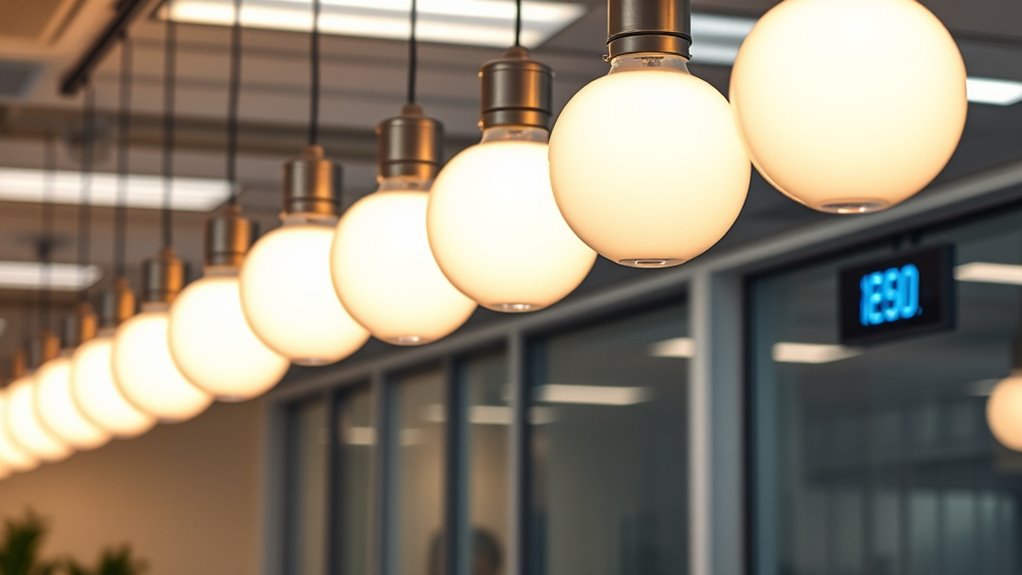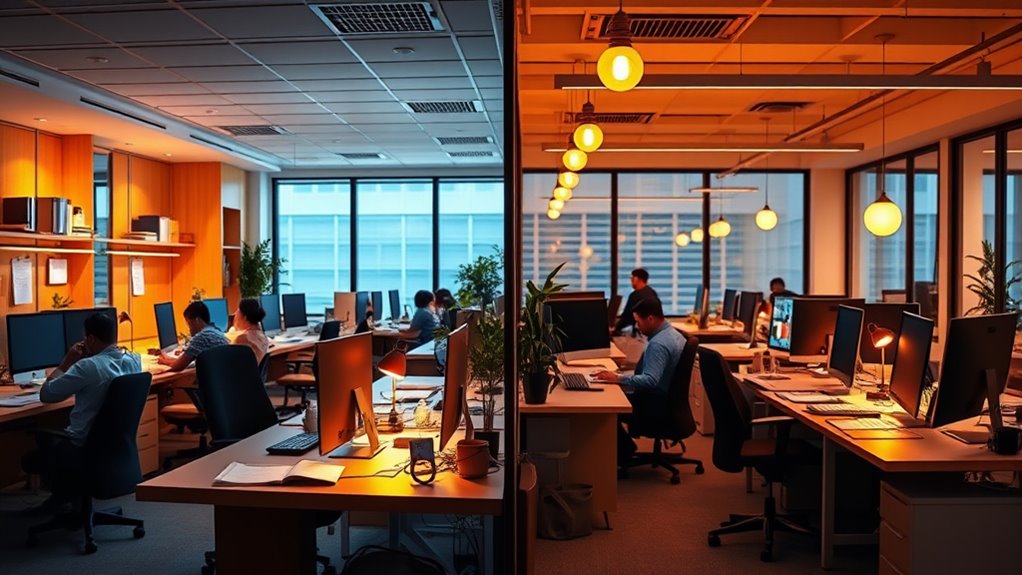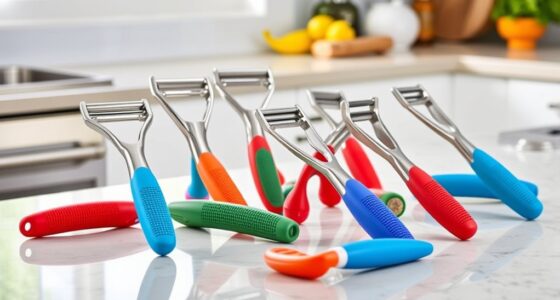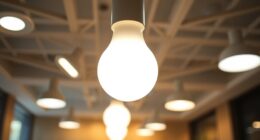Bulb temperature directly affects indoor heat levels, which can impact your comfort and productivity. Traditional bulbs like incandescents and CFLs emit a lot of heat, raising room temperatures and causing heat stress. Upgrading to energy-efficient LEDs reduces heat emissions by up to 86%, helping maintain a cooler workspace. Keeping temperatures in check is essential for peak performance, especially in hot environments. Curious how adjusting your lighting can boost your efficiency? Find out more below.
Key Takeaways
- Higher bulb temperatures from traditional bulbs increase indoor heat, impairing cognitive function and reducing worker productivity.
- Switching to energy-efficient LEDs lowers heat emissions significantly, helping maintain optimal indoor temperatures for better performance.
- Excessive heat from traditional lighting can cause heat stress, leading to fatigue, errors, and decreased mental alertness.
- Proper lighting choices that emit less heat support thermal comfort, which is crucial for sustaining high productivity levels.
- Reducing bulb temperature and heat output directly improves indoor working conditions, enhancing overall efficiency and workplace well-being.
How Light Bulb Temperatures Influence Indoor Heat Levels

Light bulb temperatures directly affect indoor heat levels, especially in enclosed spaces. Higher color temperatures, like those of LED lighting around 4,000 K or more, emit less heat, helping keep ambient temperature lower. Traditional bulbs, such as incandescent and CFLs, produce more heat, which can raise indoor heat levels and make environments uncomfortable. This increased heat emission can negatively impact worker productivity, especially in heat-sensitive workplaces. Switching to LEDs designed for daylight reduces heat emissions by up to 85%, contributing to cooler indoor conditions. The color temperature of your lighting influences indoor heat; cooler (higher Kelvin) lights contribute less to temperature rise than warmer (lower Kelvin) options. Managing bulb temperatures helps maintain a comfortable, productive workspace. Additionally, choosing energy-efficient lighting options can reduce overall heat output and improve indoor comfort. Proper ventilation and lighting placement also play significant roles in controlling indoor heat levels and optimizing comfort. Incorporating modern lighting technologies that focus on energy efficiency can further help in maintaining optimal indoor temperatures. Moreover, advancements in lighting technology contribute to better thermal management in indoor environments.
The Link Between Bulb Heat and Worker Performance

The heat emitted by traditional bulbs directly impacts worker performance, especially in environments where temperature control is limited. High bulb temperature from incandescent and CFL bulbs increases heat emissions, raising ambient temperature and causing heat stress. This elevated temperature impairs cognitive function and physical performance, reducing overall productivity. Replacing these bulbs with LED lighting markedly cuts heat emissions—by about 86%—which helps lower indoor temperatures and alleviates heat stress. Studies show that in heat-exposed settings, such as manufacturing, installing LEDs can boost worker productivity by over 80% at high WBGT levels above 19°C. Additionally, lighting customization tools can help optimize lighting conditions further, contributing to better worker comfort and productivity. Furthermore, integrating AI-driven environment monitoring can provide real-time data to manage indoor temperatures more effectively and maintain optimal working conditions. Implementing temperature regulation strategies can further support a stable and productive environment. Properly managing both bulb heat and overall environment conditions is essential for maximizing worker efficiency and well-being. Recognizing the importance of AI security in monitoring systems ensures that data remains protected while optimizing workplace conditions.
Energy-Efficient LEDs: A Simple Solution to Reduce Indoor Heat

Switching to energy-efficient LED bulbs offers an easy and effective way to reduce indoor heat buildup. LED bulbs use about 3 kWh annually per bulb, compared to 21 kWh for CFLs, making them far more energy-efficient. They emit markedly less heat—around 3.4 Btus versus 23.8 Btus from CFLs—leading to cooler indoor environments. This thermal benefit is especially valuable in workplaces like factories, where heat can hinder productivity. Replacing CFLs with LEDs not only cuts energy costs but also improves thermal comfort, which can boost productivity by over 80% during hot days. Additionally, the lighting upgrade typically pays for itself within a year through energy savings. By choosing LED bulbs, you gain both energy efficiency and a cooler, more comfortable space that supports better worker performance. Implementing such home security systems can also enhance safety while maintaining energy-efficient environments. Incorporating thermal management strategies further reduces heat buildup, which is crucial for maintaining indoor comfort and supporting optimal productivity in workspaces. Proper refrigeration cycle practices can also help in maintaining consistent indoor temperatures, especially in climate-sensitive environments. Moreover, understanding the personal finance management principles behind energy savings can assist in planning long-term investments in energy-efficient technologies.
Temperature Thresholds That Affect Productivity

Reducing indoor heat through energy-efficient lighting can considerably impact worker performance, especially in hot environments. Productivity declines sharply once wet bulb temperature (WBGT) exceeds around 19°C, with each 1°C rise causing about a 2-point efficiency drop. When ambient temperature surpasses roughly 29.4°C, your core temperature begins to rise, impairing performance further. Heat exposure at these thresholds triggers significant drops in task efficiency—up to 80% when WBGT exceeds 19°C. Laboratory data shows that efficiency diminishes by 1–2% per degree Celsius increase above 25°C WBGT. Recognizing these temperature thresholds is critical for implementing workplace interventions, such as cooling systems or lighting adjustments, to improve thermal comfort and minimize productivity losses in hot conditions. Additionally, understanding how thermal stress influences performance can help design better indoor climate control systems to support worker well-being.
The Science Behind Heat Stress and Cognitive Function

When ambient temperatures rise above approximately 29.4°C (85°F), your core body temperature begins to climb, directly impairing cognitive functions. Heat stress triggers a physiological response, including increased heart rate and sweating, which diverts energy from mental performance. Elevated temperatures, especially beyond certain temperature thresholds, reduce alertness, concentration, and decision-making ability. Research shows that productivity drops by 1–2% for each degree Celsius increase in wet bulb temperature above 25°C, highlighting how heat stress impacts task accuracy. As the body struggles to maintain thermal balance, cognitive decline accelerates, leading to errors and fatigue. Understanding this science reveals why maintaining essential ambient temperature ranges is vital for preserving mental clarity and maximizing productivity in heat-prone environments. Proper temperature regulation is crucial to mitigate these effects and support optimal cognitive function. Additionally, modern workplace designs increasingly incorporate climate control systems to help maintain ideal temperatures and safeguard worker performance.
Case Studies From Garment Factories and Manufacturing Plants

In garment factories near Bangalore, upgrading to LED lighting between 2009 and 2013 has shown clear benefits beyond energy savings. LED lighting reduces heat emissions, which improves thermal comfort and mitigates the temperature impact on worker productivity. Data from manufacturing plants reveal that each 1°C increase in outdoor temperature above 19°C WBGT decreases efficiency by about 2 points, but LED adoption cuts this decline by over substantially 80%. The phased rollout across 26 factories demonstrates that lower ambient heat from LEDs significantly boosts output during hot days. Because LEDs emit much less heat than CFLs, indoor thermal conditions improve, leading to increased worker productivity. These case studies confirm that upgrading lighting not only saves energy but also enhances performance in hot environments within garment factories and manufacturing plants. Additionally, the use of energy-efficient lighting can further support thermal comfort and productivity. Recognizing the importance of worker well-being, manufacturers are increasingly investing in lighting solutions that promote healthier and more comfortable working conditions.
Practical Steps to Optimize Lighting for Better Work Outcomes

Optimizing lighting in your workspace can substantially enhance productivity and well-being. Start by positioning workstations near windows or skylights to maximize exposure to natural daylight, which boosts alertness and reduces eye strain. Use light bulbs with Kelvin ratings of 4,000 K or higher to replicate daylight conditions that improve mood and focus. Adjust the brightness and angles of indoor lighting to mimic outdoor daylight, promoting better visual comfort and cognitive function. Incorporate transparent partitions or glass walls to let natural light penetrate deeper into your office environment. Remember to implement habits like the 20-20-20 rule during screen time to lessen eye fatigue. These practical steps create a balanced lighting setup that supports productivity and overall comfort throughout your workday.
Broader Implications for Workplace Design and Energy Use

| Design Element | Impact |
|---|---|
| Natural light | Enhances mood and productivity |
| Climate control | Optimizes comfort for diverse needs |
| Energy efficiency | Reduces costs and environmental footprint |
| Indoor air quality | Supports sharper thinking and health |
Balancing these factors leads to healthier, more productive workspaces that are also energy-conscious.
Frequently Asked Questions
How Does Temperature Affect Productivity?
You might notice that your productivity drops when temperatures are too high or too low. When outdoor temperatures rise above 25°C, your ability to focus and perform tasks decreases by about 1–2% per degree due to heat stress. Conversely, if it’s too cold below 19°C, your efficiency also declines. For ideal work, maintain indoor temperatures around 19°C to 25°C, where your performance peaks.
Do People Work Better in the Cold?
You might think colder environments help you stay alert, but research shows that women perform better in warmer temperatures, with a 1°C increase boosting math scores by nearly 2%. Men tend to do better in cooler settings, but overall, colder conditions can decrease comfort and productivity for many. So, whether you work better in the cold depends on your gender and personal preferences, but warmer environments often enhance performance for women.
What Is the Best Room Temperature for Productivity?
You might think any temperature works, but the truth is, the best room temperature for productivity is between 20-25°C (68-77°F). Staying within this range keeps you alert, focused, and at your peak. Going above or below can make you sluggish or uncomfortable. Women tend to perform best around 25°C, while men prefer closer to 20°C. Keep it just right, and you’ll release your full potential every workday!
What Is the Best Temperature for Focus?
You’re wondering about the best temperature for focus. To optimize your concentration, set your room temperature around 22°C (72°F), which balances comfort and alertness. If you’re working with women, a slightly warmer environment may boost your cognitive performance, while men might focus better in cooler spaces. Pair this with bright, daylight-like lighting to enhance clarity and reduce fatigue, helping you stay sharp and productive all day long.
Conclusion
By managing bulb temperatures, you can markedly boost workplace productivity. Did you know that high heat levels from traditional bulbs can decrease worker efficiency by up to 15%? Switching to energy-efficient LEDs not only cuts electricity costs but also keeps indoor temperatures lower, helping your team stay focused and comfortable. So, consider optimizing your lighting setup — it’s a simple change with powerful benefits for both performance and energy savings.









